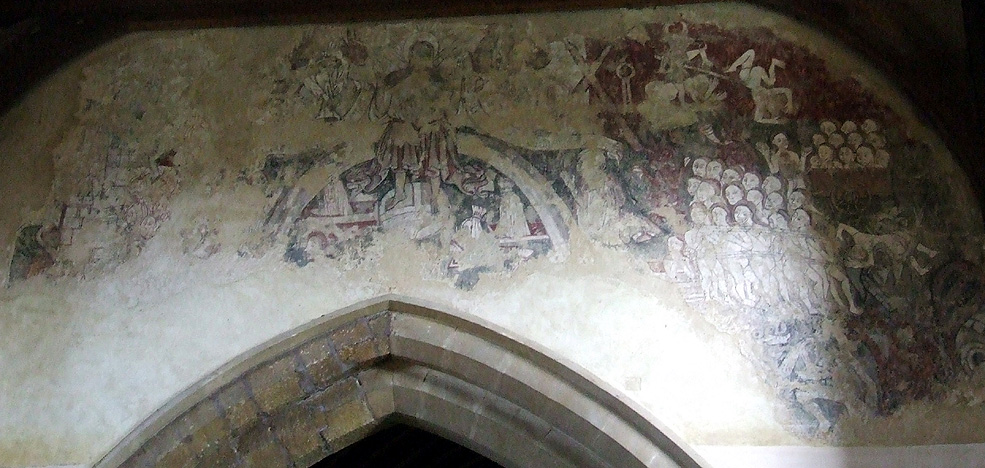Mears Ashby, Northamptonshire (†Peterborough)
Doom
An incident-packed Doom, with most of the activity on the right (or Hell) side of the painting, as is usual.

Christ sits centrally on the rainbow. Only one trumpeting angel is even partly clear, but two speech-scrolls proceeding from Christ’s head can be made out. A figure kneeling beyond the arch of the rainbow at the right is most likely to be John the Baptist, interceding for souls being judged – the Virgin Mary, chief intercessor, would normally be on the left (i.e. on Christ’s right hand), but I cannot located her in this painting.

There is scant detail on the left of the painting – some brickwork probably representing towers of Heaven, and beside it a group of raised souls in the standard shrouds knotted on top of the head. The souls are grouped on the right of the detail (left), their expressions unreadable, while Peter is at the far left, haloed and standing in a round-arched doorway peering at them in an almost shy manner. There is a glimpse of a chain just right of centre, and several crosses of a type sometimes seen on burial shrouds, above and to the left of this. The eventual fate of this group of souls seems very uncertain. The treatment of the brickwork here puts me in mind of that at Old Weston, also in Northamptonshire, and that at Yelden(or Yielden) which is forthcoming. Christ sits with his feet on the orb of the world (his footstool) and within the arch of the rainbow below him, more shrouded souls rise. On the (onlooker’s) right, beyond the seated Christ, are two of the Instruments of the Passion – the Cross and the pincers for removing the nails. Other Instruments were probably here originally, but have been lost or faded against the background.

On the right hand side of the painting all is activity, as so often, as condemned souls receive their punishment. At the top, a devil with prominent horns straddles a woman while spearing another to send her tumbling upside-down towards a cart packed with other reprobate sinners. Devils in various shapes and sizes stand in the background, one of them blowing a horn. Directly below the falling woman, standing beside the cart, and apparently secured to it, is a male figure holding a jug or ewer of some kind. It is not easy to be sure what this detail implies, but the singling-out of this figure suggests some specific meaning, and some specific sin. In this case, and especially as the man is standing on the opposite side from the shafts of the Hell-cart I suspect that it has something to do with the false measure of assayed goods such as beer and ale – the mercantile cheating which so incensed medieval people. Perhaps this man is destined to be eternally whipped at the cart-tail, or some similar penalty – at any rate he has been condemned for reasons similar to those operating in the case of the Coventry alewives or the various miscreants in handcarts at Bacton, and Yaxley. The cart, at any rate, is the clearest and most striking of any I have seen in an English Doom.
I am becoming convinced that the expression ‘going to Hell in a handcart’ originated in visual form, probably from a painting such as this example from Mears Ashby. The expression does not seem to be recorded in English before the 17th century, but ‘not recorded’ means simply that, and it is quite possible, in an illiterate age, that homely expressions, especially admonitory ones such as this, were commonplace in the Middle Ages. Anyone interested in pursuing this issue further should consult first MP Tilley, Dictionary of the Proverbs in England in the Sixteenth and Seventeenth Centuries (Ann Arbor, 1950).